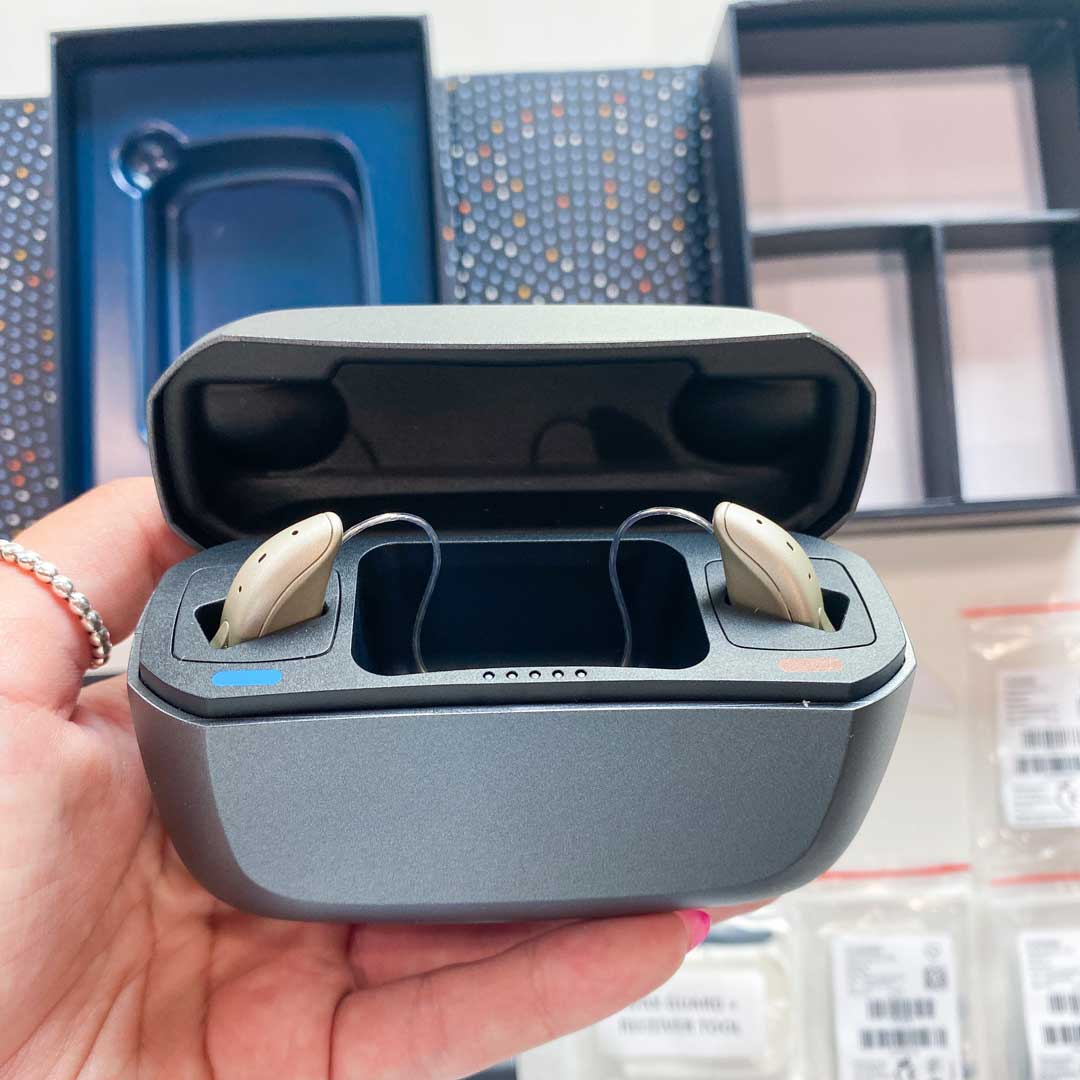What Is a Hearing Aid?
A hearing aid is a medical electronic device worn in or behind the ear to improve hearing by amplifying sounds. These devices can treat mild to severe hearing loss.
Today’s hearing aids use digital technology in a computer chip. A microphone built into the hearing aid receives and converts sounds into electrical signals. An amplifier then makes the electrical signal louder and transmits it to a receiver, or speaker, that produces the amplified sound in the ear for the brain to eventually interpret.
Types of Hearing Aids
Behind-the-Ear (BTE) Hearing Aids
BTE hearing aids sit behind your ear and have a plastic tube that loops over the top of your outer ear. That tube connects to an earpiece that sits in front of the ear canal. The piece behind your ear, known as the hard shell, holds the hearing aid technology—the microphone, amplifier, speaker, battery, and, when included, the T-coil. BTE devices can treat more severe hearing loss because they’re capable of more amplification than other styles, are easy to repair, are generally comfortable, and have room to hold more advanced technology. They’re also less likely to have feedback and whistling than in-the-ear (ITE) hearing aids. BTE devices are not as discreet as ITE hearing aids and can irritate the back of your ear, especially if you wear glasses.
Mini Behind-the-Ear (mBTE) Hearing Aids
Mini BTE hearing aids, also known as receiver-in-canal hearing aids, are similar in appearance to BTE hearing aids but have a slimmer hard shell and a receiver that sits in the ear canal at the end of the plastic tube instead of in the hard shell like with the BTE. Smaller wires of the mBTE that fit in the ear are meant to reduce the sensation of a clogged ear canal that can accompany the BTE models. A drawback of mBTE hearing aids is that they don’t amplify low frequencies as well as some other hearing aid styles and, therefore, may not be the best option for severe hearing loss.
Traditional in-the-ear (ITE) Hearing Aid
The hard shell of ITE hearing aids sits completely inside of the outer ear instead of behind the ear like with BTE hearing aids. ITE hearing aids are custom-fit to your outer ear shape and size. They are capable of Bluetooth streaming and telecoil and can treat mild to severe hearing loss. ITE hearing aids are the largest of custom hearing aids and may pick up more wind noise than smaller hearing aids. Because of their larger size, they completely block the ear canal. Blocking the whole ear canal may not be the best idea for people with milder hearing loss who can still process some sounds naturally. These and other hearing aids that go farther in the ear canal may be more difficult to place if you don’t have good hand dexterity.
In-the-Canal (ITC) Hearing Aids
Like ITE hearing aids, in-the-canal (ITC) hearing aids are custom fit to your ear canal but smaller in size and, therefore, less visible than ITE hearing aids. ITC hearing aids can treat mild to moderate hearing loss in adults. Because they are smaller in size than ITE hearing aids, they may not be able to fit some technology, like telecoil or longer battery life, into their hard shell, but they’re able to fit more technology than completely-in-the-canal hearing aids. ITC hearing aids are known to be susceptible to earwax clogging their speaker, which can affect sound quality.
Completely-in-the-Canal (CIC) Hearing Aids
Completely-in-the-canal (CIC), or invisible, hearing aids are the smallest hearing aid style available and are not visible once placed in the ear canal. They are appropriate for mild to moderate hearing loss. Because they’re hidden in the canal, they’re less likely to pick up wind noise, but their small size also limits how much technology they offer—these hearing aids are too small to offer Bluetooth streaming and batteries with a longer battery life, for instance. With their placement in the ear canal, they’re also more susceptible to earwax clogging their speaker.
How to Choose the Right Hearing Aid
To choose the right hearing aids, you need to make sure they fit comfortably in your ears and improve your hearing. Here are four steps to take to find hearing aids that are right for you:
- Schedule an appointment with an audiologist to complete a professional hearing test that tells you what type of hearing loss you have and how severe it is. An audiologist can then make specific recommendations on hearing aids to match your hearing loss and let you try out different hearing aid styles.
- Consider how hearing aids feel when wearing them. Hearing aids come in different styles that can provide different levels of comfort when in your ears. If you’re very particular about how well a hearing aid fits in your canal, you may be better off getting a prescription custom-fit hearing aid that’s shaped based on a mold of your ears. OTC hearing aids with a variety of ear tips to switch between can increase your chances of finding a comfortable fit that still amplifies sounds in a way that improves your hearing.
- Note the length of your hair. Sheri Mello, Au.D, with Raleigh Hearing and Tinnitus Center told us that people with long hair typically don’t like the feeling of their hair brushing against and getting snagged on bulkier hearing aid models. She tries to fit her patients who have long hair with in-the-ear hearing aids to avoid this source of discomfort.
- Factor in your lifestyle, including when you’re likely to use your hearing aids. If you have an active lifestyle, smaller hearing aids that are sweat resistant may be your best option. If you love watching television, hearing aids with Bluetooth audio streaming will enhance audio quality. In our AgingInPlace.org hearing aid user focus group, we learned that people who regularly wear masks have trouble with behind-the-ear hearing aids because of their mask straps getting caught on them.













